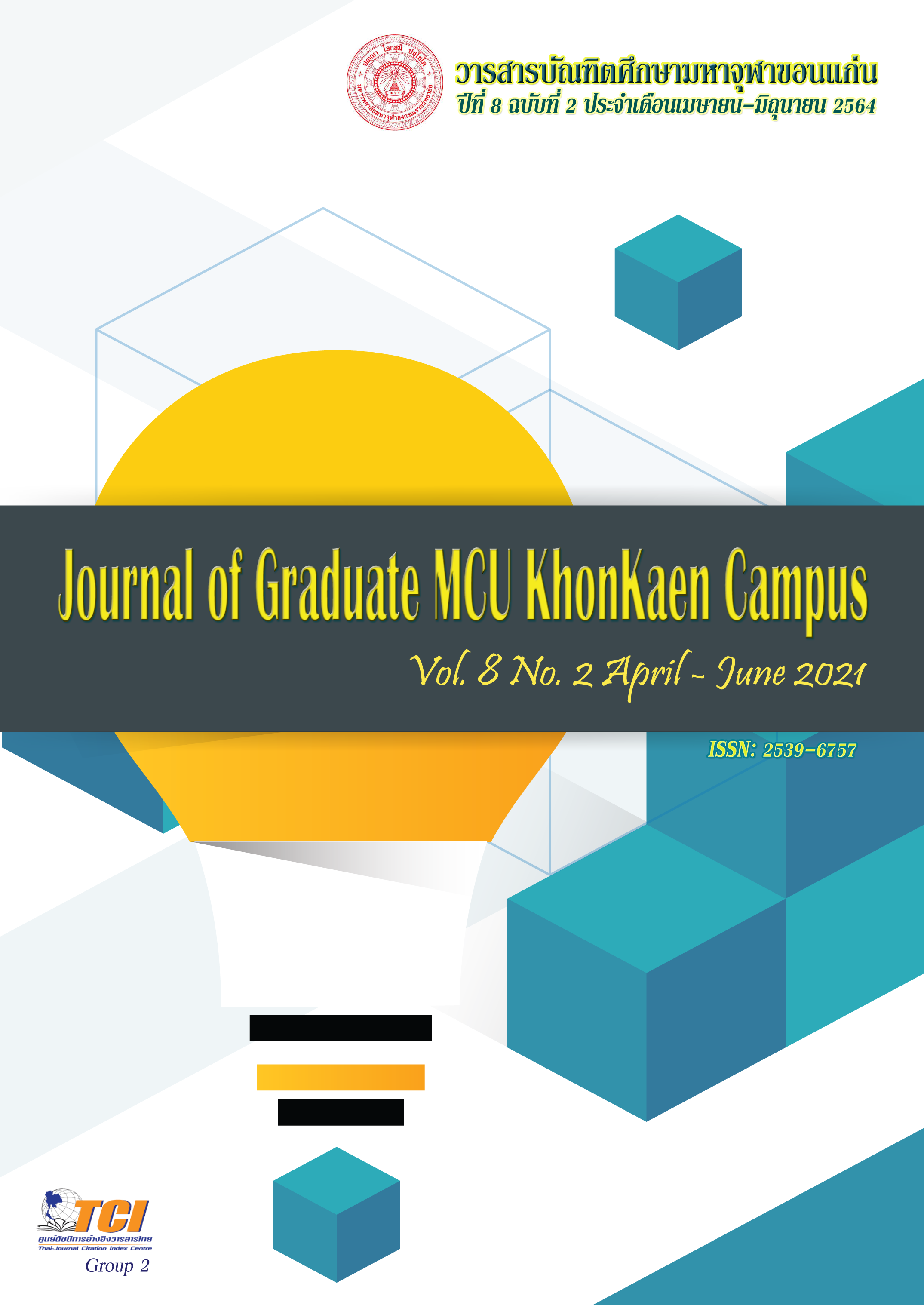THE CAUSAL RELATIONSHIP MODEL OF LEARNING STRESS AMONG HIGH SCHOOL STUDENTS IN ONLINE CLASSES DURING THE COVID-19 OUTBREAK IN MUANGPHAYALAE WITTAYA SCHOOL, CHAIYAPHUM PROVINCE
Main Article Content
Abstract
The COVID-19 pandemic has become a global health issue and has had a major impact on education. In Thailand, many schools have been forced to transit from face-to-
face to online learning. The purpose of this quantitative research was to develop a causal relationship model of learning stress among high school students in online classes during the COVID-19 outbreak in Muangphayalae Wittaya school, Chaiyaphum province.
The model consisted of three latent variables including teaching and learning, relationship with friends and teachers, and learning stress based on conceptual framework of the research. The samples were 1,845 high school students selected by purposive sampling method.
The data were collected by using self-administered questionnaires between January and February 2021. The questionnaire content was validated by three experts. The reliability of the questionnaire was 0.80. It was tested and computed by using the Cronbach’ s alpha coefficient. The data were analyzed by descriptive statistics and structural equation
modeling.
The findings showed that the adjusted model was consistent with the empirical data as demonstrated by the following fit measures: chi-square test = 18.200 , df = 13, p = 0.150, RMSEA = 0.015, SRMR = 0.011, CFI = 0.998, TLI = 0.994, all variables in the adjusted model account for 86% of the total variance in learning stress.
Article Details
References
กระทรวงศึกษาธิการ. (2563, 18 พฤษภาคม). จากอนุบาล 1 ถึงอาชีวศึกษา วันแรกของการเรียนออนไลน์ในยุคโควิด-19. ข่าวสด. สืบค้นเมื่อ 27 กุมภาพันธ์ 2564, จาก https://www.khaosod.co.th/bbc-thai/news_4151848
จันทร์ทิพย์ สุขรมย์. (2559). ปัจจัยที่มีอิทธิพลต่อความเครียดของนักเรียนชั้นมัธยมศึกษาตอนปลายในโรงเรียนสังกัดสำนักงานเขตพื้นที่การศึกษามัธยมศึกษาเขต 20. ใน วิทยานิพนธ์ปริญญาครุศาสตรมหาบัณฑิต สาขาวิชาวิจัยและประเมินผลการศึกษา, บัณฑิตวิทยาลัย: มหาวิทยาลัยราชภัฏมหาสารคาม.
พูลพงศ์ สุขสว่าง. (2557). หลักการวิเคราะห์โมเดลสมการโครงสร้าง. วารสารมหาวิทยาลัยนราธิวาส
ราชนครินทร์, 6(2), 136-145.
มหาวิทยาลัยทักษิณ. (2563). เน้นเชิงรุก การศึกษาหลังยุคโควิด-19 ต้องผสมผสานทั้งเรียนออนไลน์ในโรงเรียนและมองย้อนที่ตัวเอง. สืบค้นเมื่อ 25 กุมภาพันธ์ 2564, จาก https://mgronline.com/south/detail/9630000056121
สถาบันวิจัยและบริการวิชาการ มหาวิทยาลัยอัสสัมชัญ. (2563). การเรียนออนไลน์ในสถานการณ์ COVID-19. มติชน. สืบค้นเมื่อ 23 มกราคม 2564, จาก http://matichon.co.th/Covid19/news_2146713
สิรินิตย์ พรรณหาญ, บุญมี พันธุ์ไทย, กมลทิพย์ ศรีหาเศษ. (2561). ปัจจัยที่มีผลต่อความเครียดในการเรียนของนักศึกษาแพทย์ชั้นปีที่ 4-6 คณะแพทยศาสตร์โรงพยาบาลรามาธิบดี มหาวิทยาลัยมหิดล. Veridian E Jounal (Humanities, Social Sciences and arts), 11(3), 2579-2593.
สิริพร อินทสนธิ์. (2563). โควิด-19 กับการเรียนการสอนออนไลน์ กรณีศึกษา รายวิชาการเขียนโปรแกรมเว็บ. วารสารวิทยาการจัดการปริทัศน์, 22(2), 203-214.
สำนักงานศึกษาธิการภาค 2. (2563). เสียงสะท้อน "เรียนออนไลน์" ความไม่พร้อมของการศึกษาไทยช่วงโควิด-19. สืบค้นเมื่อ 27 กุมภาพันธ์ 2564, จาก http://www.reo2.moe.go.th/home/index.php/site-administrator/2018-11-02-03-22-34/763-19-23-2563
อรวรรณ ศิลปะกิจ. (2551). แบบวัดความเครียดฉบับศรีธัญญา. วารสารสุขภาพจิตแห่งประเทศไทย, 16(3), 177-185.
โรงเรียนเมืองพญาแลวิทยา. (2563). ข้อมูลนักเรียน. สืบค้นเมื่อ 26 มกราคม 2564, จาก http://www.phayalae.ac.th/datashow_48556
AlAteeq, D. A., Aljhani, S., AlEesa, D. (2020). Perceived stress among students in virtual classrooms during the COVID-19 outbreak in KSA. Journal of Taibah University Medical Sciences, 15(5), 398-403.
Fawaz, M., Samaha, A. (2020). E-learning: Depression, anxiety, and stress symptomatology among Lebanese university students during COVID-19 quarantine. Nursing Forum an Independent Voice for Nursing, 56, 52-57.
Hair, J.F., Black, W.C., Babin, B.J. & Anderson, R.E. (2010). Multivariate data analysis.
(7th ed.). New Jersey: Prentice-Hall.
Jena, P.J. (2020). Online learning during lockdown period for Covid-19 in India.
International Journal of Multidisciplinary Educational Research, 9(8), 82-92.
Livana, P.H., Mubin, M.F., Basthomi, Y. (2020). "Learning task" Attributable to students’stress during the pandemic Covid-19. Journal Ilmu Keperawatan Jiwa, 3(2), 203-208.

